Human settlement in England
| Great Henny | |
|---|---|
 Great Henny Great Henny | |
 | |
| Population | 191 |
| District | |
| Shire county | |
| Region | |
| Country | England |
| Sovereign state | United Kingdom |
| Post town | SUDBURY |
| Postcode district | CO10 |
| Dialling code | 01787 |
| Police | Essex |
| Fire | Essex |
| Ambulance | East of England |
| 52°00′25″N 0°43′08″E / 52.007°N 0.719°E / 52.007; 0.719 | |
Great Henny is a village and civil parish in the Braintree district in the county of Essex, England. Nearby settlements include the villages of Little Henny and Twinstead and the Suffolk market town of Sudbury. The hamlet of Henny Street, within the parish, is on the River Stour which forms the parish's eastern border. It shares a parish council with Little Henny and Twinstead called "Hennys', Middleton & Twinstead".
Location
In 1870 the parish was described as "on the river Stour and the Sudbury railway, at the boundary with Suffolk, 2 miles S of Sudbury r. station. Post town, Sudbury." Great Henny is approximately 11 miles (18 km) north-west of Colchester and 11 miles north-east of Braintree.
St Mary's Church
St Mary's Church is the only church within the parish, and is the Church of St Mary the Virgin. The church is thought to have first been built in the 11th or 12th century and then later extended in the 14th century. The church is also registered as a Small Place of Pilgrimage. It is a Grade II* listed building.
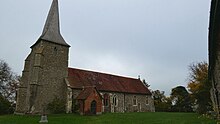
Housing
In the parish of Great Henny, information has showed that there has always been a small amount of housing in the area, with the highest number of houses between 1831 and 1961, according to census information, being 88 in 1851. This number had slowly increased from 1831 however after 1851, the number of houses within the area began to slowly decrease and the census information in 1961 showed that in total there were 58 total houses in the area. This number had increased again, to 72 by the latest census which was taken in 2011.
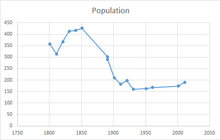
Population
According to the 2011 census, the population of Great Henny in that year was 191 people. Census data tells us that the population of Great Henny has not fluctuated majorly over the past 200 years since 1811, when census data is available for Great Henny. Over each ten-year period when the census was taken between 1811 and 1951, the population decreased every year except from the year 1951 when the population increased by 3. During every other census, however, the population was seen to decrease, with the largest decline being in 1901, when the population had decreased by 78 from the previous census. The total number of houses within the area can be seen to have decreased within the period of 1831–1961, when this data is available. In 1861, the total number of houses was 83, and while this remained steady and actually increased to 88 in 1881, the total number of households was seen to decrease every ten years when the census was taken and in 1961 there were only 58 houses in the area. This number, however, is an increase upon the lowest number of 43 houses which was in 1931. The decrease in the number of houses could be linked to the decreasing population during these times.
Employment
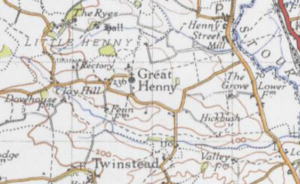
In 1831, the majority of males over the age of 20 (73% of employed males) were agricultural labourers. The next leading occupation, although only at approximately 6%, was males employed in retail and handicrafts. Still in 1881, the majority of workers worked in agriculture, followed by general or unspecified commodities. At this time however, there are also records of females being employed although records show that the majority of females worked in an "unknown occupation." Many females also worked in dress or domestic services or offices. According to the 2011 census, however, only 5 people were working in the agriculture, forestry and fishing industries. The three most popular employment categories were: professional, scientific and technical activities employing a total of 20 people, construction employing a total of 14 people followed by manufacturing providing employment for 11 people. This shows how the area and industry within the area has developed over the past 200 years.
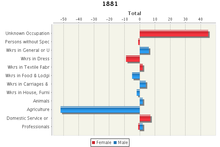
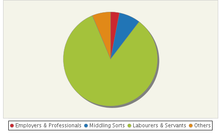
Notable people
Alice Perrers
(Main article: Alice Perrers)
Alice Perrers, (circa 1348 –1400/1401) was an English royal mistress, lover of Edward III, King of England. Some sources attribute her as the daughter of a thatcher from Henny, while others place her from several alternative locations. As no birth record of Alice Perrers remains, many unfounded theories have arisen about her parentage. The earliest tradition spoke of a lowly birth, either as a niece of William of Wykeham (1320/1324–1404), Bishop of Winchester and Lord Chancellor, or as the daughter of a weaver from Devon. According to contemporary chronicler Thomas Walsingham, she was "from the town of Henny" and "of low birth" as the daughter of a thatcher. Walsingham's account is often questioned because of his open hostility against the royal court and especially Perrers. Other evidence suggests that her birth surname was Salisbury
She became the mistress of the king, Edward III (1312–1377) around 1366, when she was around 18 years old and the king 55. As a result of the king's patronage, she became the wealthiest and most influential woman in the country. She was widely despised and accused of taking advantage of the old king.
At that same time there was a woman in England called Alice Perrers. She was a shameless, impudent harlot, and of low birth, for she was the daughter of a thatcher from the town of Henny, elevated by fortune. She was not attractive or beautiful, but knew how to compensate for these defects with the seductiveness of her voice. Blind fortune elevated this woman to such heights and promoted her to a greater intimacy with the king than was proper, since she had been the maidservant and mistress of a man of Lombardy. And while the queen was still alive, the king loved this woman more than he loved the queen.
— Thomas Walsingham, The St Albans Chronicle
Perrers died during the winter of 1400/1401, aged around 52, and was buried in the Church of St Laurence in Upminster.
References
- "The Hennys', Middleton & Twinstead Parish Council". Braintree District Council. Retrieved 10 October 2023.
- Wilson, John Marius (1870). Gazetteer of England and Wales. Edinburgh: A. Fullerton & Co. Retrieved 27 January 2015.
- "Great Henny: St Mary, Great Henny". A Church Near You. Retrieved 24 April 2015.
- "PARISH CHURCH OF ST MARY, Great Henny - 1123259 | Historic England". historicengland.org.uk. Retrieved 11 September 2022.
- "Great Henny housing statistics". Vision of Britain. Retrieved 24 April 2015.
- "Great Henny, Accommodation, 2011". Neighborhood Statistics. Retrieved 24 April 2015.
- "Great Henny (Parish): Key Figures for 2011 Census: Key Statistics". Neighborhood Statistics. Office for National Statistics. Retrieved 27 January 2015.
- "Great Henny AP/CP through time population statistics". www.visionofbritain.org.uk. Retrieved 16 March 2015.
- "Great Henny AP/CP throughout time housing statistics". www.visionofbritain.org.uk. Retrieved 16 March 2015.
- "1831 Occupational Categories". Vision of Britain. Retrieved 23 March 2015.
- "1881 Occupational Orders". Vision of Britain. Retrieved 23 March 2015.
- "Great Henny Industry 2011". Office for National Statistics. Retrieved 23 March 2015.
- Ormrod, W.M. (2006). "Who was Alice Perrers?". The Chaucer Review. 40 (3): 219. doi:10.1353/cr.2006.0005. Retrieved 30 September 2018.
- Tompkins, Laura (2015). "Alice Perrers and the goldsmith's mistery: New evidence concerning the identity of the mistress of Edward III". English Historical Review. 130 (547): 1362. doi:10.1093/ehr/cev319.
- "Alice Perrers: From royal mistress to one of England's wealthiest". Royal Central. 18 August 2021. Retrieved 18 May 2022.
- "Alice Perrers". Encyclopædia Britannica. Retrieved 7 November 2018.
- "Alice Perrers". britannica.com. Retrieved 18 May 2022.
- Kingsford, Charles Lethbridge (1896). "Perrers, Alice" . In Lee, Sidney (ed.). Dictionary of National Biography. Vol. 45. London: Smith, Elder & Co.
Further reading
External links
![]() Media related to Great Henny at Wikimedia Commons
Media related to Great Henny at Wikimedia Commons